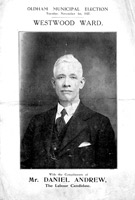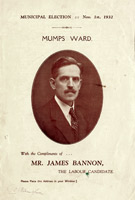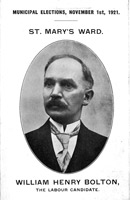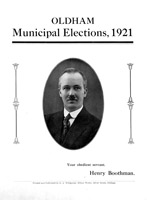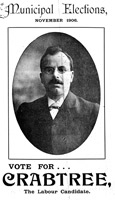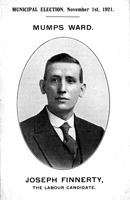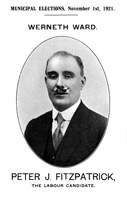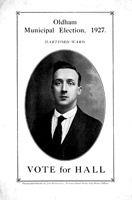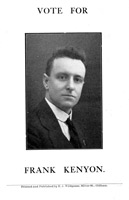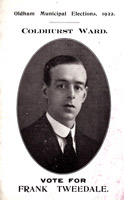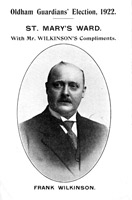
THE EMERGENCE OF A LABOUR GROUP IN OLDHAM 1910 - 1930 thumbnail links to larger image: The early socialist organisations, such as the Independent Labour Party and the Social Democratic Federation had been trying to win places on Oldham Council and the Borough's elected boards since 1892, with no success. Save the election of F.W.Potter (I.L.P.) and J.F.Broadbent (S.D.F.) to the School Board in 1894. Following Isaac Crabtree's near victory as an I.L.P. candidate in St.Paul's Ward in 1905 the Oldham Trades and Labour Council began supporting "Labour" candidates, fighting St.Paul's and St.James' Wards in 1906, St.Paul's and Westwood in 1907, St James' and St.Paul's again in 1908. St.Paul's and Clarksfield in 1909 and St.Paul's in 1910, but recording no victory until Sam Frith won a by-election in Westwood Ward in the same year. He was able to hold the seat when it came up for re-election the next year.(1) Sam Frith(2), Oldham's first Labour Councillor had been born in Stockport in 1873, his parents moving to Oldham while he was still a child. By trade he was a brass founder, working at the Globe Meter Works. By 1900 he was a delegate on behalf of the Oldham Branch of the Brass Founders Society to the Trades and Labour Council. He became Branch Secretary in 1903. (subsequently to become Assistant Secretary of the Oldham A.E.U, following amalgamations in 1917) He had consistently contested seats as a Labour candidate since 1907. In addition to his trade union activity, he was a member of the Manchester Unity of Oddfellows (an organisation of which he was at some time the Provincial Grand Master) and was involved with the Henshaw St Primitive Methodist Church. Comment in the Oldham Evening Chronicle suggested that these two links as much as his trade union standing, contributed to his early popularity. Within the Trades and Labour Council he became President in 1914, a position he held until he lost it to Frank Kenyon in 1927. It would appear that Frith was more trade union Labour than socialist Labour. The Oldham Evening Chronicle carried the comment that "as every Labour leader who is not an extremist for Socialism or Comnmunism, he had a thorn in his flesh. the I.L.P. element." The same article hints at I.L.P. mutterings against him by some Labour Council members on one of the occasions when he was elevated to Alderman. Some idea of what Frith was like as a man comes from the letter of tribute from R.W.B. (presumably Liberal Councillor Robert William Bainbridge) published in the Oldham Evening Chronicle at the time of Frith's death. Frith was apparently angered by duplicity, being very straight and honest himself. Although he could enjoy a joke, he lacked an inventive sense of humour. In debate he was not concise, but could state his case clearly, and his debating skill was enhanced by a retentive memory, which he used to quote back the previous speeches of other councilors. According to RWB you could tell Sam Frith meant business when he put his papers down, took off his glasses and spoke with his right arm outstretched. Frith was to serve on the Council continuously for twenty one years, not only being the first Labour Councillor but in 1926, Oldham's first Labour Mayor as well. For the first nine of those years, he was to serve as the only representative of organised Labour on the Council. For the rest of the time, until his death, he was to preside, as Caucus Leader, over what was largely a steadily increasing Labour presence. The early election of further Labour candidates was probably retarded by the First World War when, from the outbreak of the war until 1919, there were no contested elections and vacancies on the council were filled by agreement between the existing Councillors and Parties. By the time municipal elections re-commenced in 1919 two events had occurred at national level were to have an effect on both elections and the Labour Party. The first was the Representation of the People Act of 1918, which brought in almost universal male suffrage over the age of 21 on both a residential or ownership criterion and, for the first time, limited female suffrage for women over thirty who were householders or the wife of a householder. Plural voting was limited to one residential and one business premise. The effect was to virtually double the electorate. Frith had wooed 2603 electors in Westwood Ward in 1910. He had to face 5410 when he sought re-election in 1921(3). Other wards show similar growth. So for example between 1913, the last pre-war electoral register and 1919, the first post war electoral register, Hollinwood went from 1914 to 3702 electors, St.James' from 2416 to 4351 and Mumps from 1710 to 2954. The other event was the decision of the Labour Party at its Annual Conference in 1918 to adopt a new constitution. Prior to this it had been a wholly federated structure with affiliations from trade unions and socialist societies such as the Fabians and the I.L.P. in which trade union interest and socialist idealism had found common ground Now it re-organised as a party with local constituency (in Oldham the Trades and Labour Council would adapt to this role) and ward branches for individual members. Most particularly it adopted a set of objectives which gave it a clear socialist agenda, which Beloff (1983) argues, made "it clear that Labour was no longer an appendage of Liberalism but a competitor for power in its own right." However, although the socialists had asserted themselves in terms of Labour Party purpose, the difference between socialist and non-socialist elements in the Labour and trade union movements was not necessarily settled, neither nationally nor locally. Bennett (1967) traces the conflict from the 1890s onwards between the socialist and non-socialist elements in the Oldham Trades and Labour Council. That the problem still seems to be current can he deduced from the instance cited above relating to Sam Frith's difficulties with the “I.L.P. element" during his Presidency of the Trades and Labour Council. Certainly if the Oldham Trades and Labour Council was going to seek socialist and trade union support from the enlarged electorate, following the adoption of the new constitution, there was still an element of non-political trade unionism that was, and would remain inimicable. In a letter in the Oldham Evening Chronicle, on the eve of the municipal elections in 1921, an anonymous "General Worker" argues that the so called Labour candidates have no right to use the name Labour because they are pure and simple socialists. He continues to point out that although these Labour candidates might claim the support of the thousands affiliated to the Trades and Labour Council, he asserts that the majority of the Trades and Labour Council membership are "Liberals, conservatives, waverers and non voters".(4) In 1923, James Crinion, President of the Oldham Card Blowing and Ring Room Operatives Association and who had been, in 1908, Oldham Trades and Labour Council's prospective parliamentary candidate reviewed the development as follows:- Commenting that he had attended every Labour Party Conference since the party's formation he noted, "the march of events has persuaded me, as a believer in progressive trade union methods to attend no more.” The Labour Party, in turning to Socialism is "now neither more nor less than a national organisation out to capture everything in the country for a formula that I have never believed in as a solution of the wrongs under which we live."(5) As the new electoral registers with the expanded electorate were published in the middle of February 1919, Reginald Hewitt of the N.L.T.G.W. would have the privilege of being one the first people elected on the extended franchise, when he won a by-election for Labour in Westwood on February 27th(6) On a low turnout, the majority was a substantial 454 votes. In commenting on his result Hewitt paid regard to "a larger number of workers drawn from all sections of the trade union and Labour movement than had been the case on any previous occasion." Little otherwise is known about this second Labour Councillor, who did not re-contest his seat when it came up for re-election in November 1920. The Oldham Trades and Labour Council contested four seats in the municipal elections on November 1st 1919, while the Co-op Party, not yet in formal alliance with the Labour Party, contested a further two. None was successful, and the Council remained comfortably in Liberal control, with the Liberals holding twenty seven seats to the Conservatives seventeen. Labour held two, the PSA Brotherhood one and there was one vacancy. However, the by-election to fill the vacancy, held seventeen days later in St.Mary's Ward saw the comfortably election of Isaac (Ike) Crabtree. Ike Crabtree(7) was older than Frith, having been born in Essex St.. Oldham in 1867. One of a poverty stricken family of twelve, his mother worked as a hand reeler at home toearn extra money. The young Crabtree attended Glodwick Baptist School before becoming a half-timer at Platts Old works at the age of ten. Later he was an apprenticed iron moulder, working not only for Platts, but also for W W. Haigh. Certainly by 1889 he was an active trade unionist. However in 1896 his, failing eyesight forced him out of the engineering trade. For the next nineteen years he was to work as a collector for the Oldham Mutual Sick and Burial Society until he was appointed full time Secretary to the Trades and Labour Council at £2/10/- a week. Crabtree was very much committed to the cause of his fellow men. An active Salvationist, he had the reputation of meeting prisoners on their discharge from Strangeways and helping them to get back to their families. It is believed that he also paid others' fines to prevent them from going to prison. During the years before the First World War, he organised the unemployed and led them in marches around the town. In its obituary, the Oldham Evening Chronicle, stated "he could always feel for the bottom dog and when necessary was prepared to take risks and face public odium in the hope of bringing about the desired results." Politically he was an I.L.P. socialist, standing under that banner for the Council as early as 1904. He knew Keir Hardie and Ramsay McDonald and was a friend of J.R.Clynes, the Oldham trade unionist who went on to be a Labour M.P. and Cabinet Minister. During the fight for women's suffrage he had assisted Mrs.Pankhurst on occasions. He was to be Oldham's second Labour Mayor in 1929, when he ruffled some municipal feathers by having his Churching of the Mayor ceremony at the Salvation Army Citadel. The Oldham Evening Chronicle said he had the reputation of being a good debater with a sense of humour. Five seats (Labour 4, Co-op1) were contested in 1920, but the only success was Crabtree's comfortable retention of his seat in St.Mary's. 1921 however saw not only Labour's heaviest assault yet on the Council but also significant counter measures by the other two parties. On October 5th 1921, the Oldham Evening Chronicle carried a report of the Trades and Labour Council's decision to contest eight wards. Within days the other parties had responded. The weekly Oldham Chronicle (15/10/21) revealed informal conversations between the Liberals and the Conservatives on the previous Thursday to see if a compromise could be reached regarding the forthcoming elections to arrange that Conservative and the Liberal would not oppose each other. A week later a pact had been agreed. The Oldham Standard of October 22nd describes it as a pact initially binding for two years, in which the Liberals and the Conservatives would only contest against each other in Westwood and St.Paul's. Conservatives would be supported by Liberals in Waterhead, St.James, St.Mary's and Hartford, whilst the opposite would apply in the remaining six wards although there were difficulties in implementing the pact so close to the elections with campaigns already underway. The pact seems to have been effective and long lasting. Of the eighty nine contested elections for Council seats between 1921 and 1930 only fifteen were three comer fights involving the three main parties.(8) There is evidence to suggest that in the period 1922 to 1926 the pact was tightened, with no three-corner fights at all between 1922 and 1926. In the entire period Labour candidates were faced with twenty five straight fights against the Liberals and forty three against the Conservatives. The Liberals had to face minority candidates on a few occasions. Only after 1927 do the Conservatives start to take on both Liberal and Labour candidates in three corner fights. Perhaps the established parties were right to fear the rise of Labour, who, in 1921, enjoyed their best success so far. Not only was Sam Frith re-elected in Westwood, William Bolton took another of the St.Mary's seats, and Henry Boothman benefited from the three way split to win St.Paul's taking 1412 votes to the 1216 gained by the Conservative and the 1170 gained by the Liberal. With the pact fully operational in the next year, the St.Paul's anti-Labour vote topped 2500. In fact Labour was never again to win the seat before the end of the County Borough in 1974! Henry Boothman J.P. was by occupation a full time officer of the Operative Spinners Amalgamation. Boothman did not seek re-election to the Council in 1924. His political and trade union career took a different course, eventually seeing him as a member of the General Council of the T.U.C. William Bolton (known for his short stature as "Little Billy Bowton") had been born in 1868. He was a flyer maker with William Bodden and Son. William Bodden had been Mayor in 1877 and in his election address Bolton was able to announce that his employers of forty years had promised to release him from work as much as was required to do his duties should he be elected. As with many of the early Labour candidates he too held union office, in his case, as Secretary of the Spindle and Flyer Makers Union, Number 2 Branch. Like Frith, he was a member of Henshaw St. Methodist Church Of the the eight Labour seats contested in 1921, five of the election addresses have survived. They indicate clear differences in appropach between the candidates from the textile unions (Boothman - St Paul's, Birchenough - Hollinwood) and the engineers/I.L.P.ers (Bolton - St Mary's, Finnerty - Mumps, Fitzpatrick - Werneth) Physically the textile men's election addresses are larger and carry less text while the others are more compact and carry more information. But it is in the content, particularly relating to unemployment, where the real difference shows. Boothman's election address committed him to enlightened and generous policies, in accordance with the principles of the Labour Party, but he cites few specifics. A supportive commitment to a quotation by Prime Minister Lloyd George on unemployment suggests an affinity with old Lib-Labism. He continues by commenting that it is "probable that additional responsibilities will be placed on the Town Council in the attempts by Parliament to solve this urgent problem and it is very necessary that Labour should be able to make its influence felt."(9). And from his colleague Birchenough, "I look on it (unemployment) as a national question to be dealt with effectively by the government" (9a) By contrast, Bolton's election address is much more specific on issues relating to gas, electricity, housing, sanitation and the rates. On unemployment he is much more direct. He recognises it is a national problem but he 'strongly urge(s) on the Town Council to at once put in hand such schemes as would act to the public good, and be the means of absorbing a large number of our unemployed.(10) Finnerty points out the urgency, "..something will have to be done quickly to deal with the distress we have in this Town. I shall support schemes that will create a demand for Labour" (10a) Even before the next municipal elections Labour gained another Councillor when James Shannon, who had been a Liberal Councillor for St.Mary's since 1915, crossed to the Labour benches in the August of 1922. This gain was initially short lived as Shannon lost his seat in the November, although he returned, unopposed, to fill a casual vacancy in the ward in the next year. Born to a tenant farming family in Ennis in County Clare, Ireland, James Shannon(11) had twice been evicted and homeless before coming to England. Prior to arriving in Oldham in 1895, he had tried his hand as a surface worker at a Westhoughton coalpit and as an employee of the LNWR in its goods yards, where his personality and ability was such that he was made a chargehand over a hundred and forty men within two weeks. After some time as a foreman at the Spring Vale and Rushbank Mills, he began a butter business in 1898 at a premise at Bottom o'th' Moor. Reputedly he was to build up his not inconsiderable provision business from the profits from one barrel of butter. A Roman Catholic by religion, he was a member of St Patrick's parish and very involved with the charitable St.Vincent de Paul Society. If November 1922 saw the brief disappearance of Shannon from the Labour benches, it also saw the arrival of Frank Tweedale in Coldhurst, the only success out of eight contests for Labour. Tweedale's election address (12), although directed specifically at the electors of Coldhurst, gives a feel of the issues the Oldham Labour Party was fighting on in 1922. The document shows a burgeoning optimism, "I come before you as a representative of an organisation that is destined in the next few years to be the ruling power in local and national affairs" as well as a stirring policy aim: 'A policy to improve our working and living conditions and to guarantee that our children and those who come after will not have to struggle and scrape as we and our parents before us had to do.' Its specific policy points concern unemployment and housing. Unemployment is "obviously a product of the present social order" and Tweedale suggests that much more coul;d be done by the Borough to initiate schemes to take on the unemployed. On the housing front, the local authority is accused of mishandling its powers to build new council housing with the result that, that which was being built was at exorbitant rents for working class families. Tweedale reminds his electorate: "Every vote given to the other side is a vote for private gain; every vote given to Labour is a vote for the common good" and ends with the clarion call, "Strike a blow on November 1st for your own class and for justice for all." A message like this may have resulted in only one gain at the municipal elections, largely because of the effect of the Liberal/Conservative pact. Only fifteen days later however, in the General Election of 1922, Oldham had its first Labour M.P. in William John Tout. This was in many ways a remarkable victory. Oldham was a two-member seat, electing two M.P.s, but the Trades and Labour Council could only afford one candidate. It campaigned to persuade its supporters to only use one vote. Of the 24,434 votes cast for Tout, 20,771 voted for Tout alone (Tout was re-elected December 1923, but defeated at the end of the first minority Labour Government in 1924). Frank Tweedale(13) brought the strength of the Labour Group back to five. He had been born in 1888 in Waterhead. He had been educated at the local council school and at an establishment known as "Greenacres Grammar School". He began work as a half-timer at the age of ten, first as a check lad at the engineering firm of Asa Lees and later in a cotton mill where he became a fully fledged little piecer. Finding this work uncongenial, he was able to secure an apprenticeship as a fitter at Platts, filling out his education from the age of thirteen at Derker Night School and later at Oldham Technical School. He was to become a fitter-out with Platts, working as far away as Bohemia. He had joined the I.L.P. in his teens and had become wholeheartedly involved in its activity, at one time being a nominee to its Parliamentary Panel. Active in both his trade union and the co-operative movement, he was a shop steward at Platts and eventually District President of the A.E.U., and served for five years on the board of the Oldham Equitable Co-operative Society. James Shannon, as noted above, rejoined the Labour Group in 1923 bringing it to six members, a figure that remained unchanged until 1926. Crabtree held St.Mary's in 1923 and Herbert Barnett made up for the departure of Boothman by winning a by election in Hartford in 1924. Barnett was an insurance agent ,and a previous Co-op Party candidate. He was to hold Hartford for three consecutive terms. The other members of the Group held their seats when due for re-election. On Sam Frith's second elevation to the Aldermanic Bench in 1926, James Parsons, an engineer was elected unopposed in Westwood, taking the number of Labour Councillors to seven. The Oldham Trades and labour Council had begun publication of a monthly "Labour Gazette" in January 1923. Its early editions are largely a platform for national trade union and Labour issues and spokesmen, but it did turn its attention to local affairs in its November issue each year in preparation for the municipal elections. Unfortunately the issues for November 1923 and 1924 have not survived, but the issue for November 1925(*) gives us our first overall Oldham Labour Party manifesto, as opposed to individual candidates' statements. Even so the arguments are based on national situations rather than local specifics. The main themes relate to rates, housing, education, unemployment and health, together with sections arguing why Labour needs to be represented on local authorities and why women should vote Labour. With regard to the rates, the document argues that instances across the country of rate reductions can not be credited to controlling "anti-Labour groups" but reflect an upturn in the post war economy. Nevertheless it does argue for further spending.
and draws attention to the imbalance in the value of the rates between rich borough's such as Kensington and Bournemouth and poorer boroughs such as Barrow and Bethnal Green, which mean that "a penny rate raises about twice as much money in the towns and districts that need it least." This is a burden that Labour wishes to see re-adjusted. Turning to housing, much is made of the 1923-24 Labour Government's Housing Act, subsidising homes built to let at a reasonable level, which had not been fully exploited by local authorities. In addition it commends the use of direct labour, citing the example of the Bradford direct works department building houses for £986 when private contractors were asking for £1,126. Quality of housing is also important. "We must not create the slums of the future by building badly now" The education policy focuses on class size and the lack of secondary school places. It rails about national statistics showing 4736 classes of 60+ children and 20,617 classes of 50+ and the presence of two and a quarter million 11 to 16 year olds completing their education in elementary schools rather than specific secondary provision. Positive initiatives on school building and class sizes by the recent Labour Government are highlighted. Labour now expects Local Authorities to implement a four point plan "To build more schools, To improve present schools, To pay teachers well, To increase Secondary Education" The public health policy also makes play about under used provision created by the Labour Government. It calls on Local Authorities to make full use of the grants made available for mother and child care and the treatment of tuberculosis: "It is good economy to prevent disease". The burden of the poor law on the rates as a result of unemployment is condemned and the point is made that local Labour Councillors should promote employment constructively. The general call to the electorate for support reaches out from a class base to claim the policies benefit the community as a whole. "The prevention of disease, the promotion of of education, the prevention of unemployment are not 'class' measures, but will have good effects which all persons in all classes will share." The appeal to women voters is based on the principles of "Clean and prosperous towns and villages, well built convenient homes, happy sturdy children (and) cheerful healthy mothers", warning that "with the Tories in power, all Labour's reforms are in danger." The slogans accompanying the text are, however, very class oriented, demanding voters "come and support the workers' candidates", who "live and work amongst you". The Liberal-Tory pact is alluded to by seeking a "protest against the Liberals and Tories" who are "forming cliques to do away with elections which will ultimately mean the ruin of real municipal Government." During the early twenties, in many wards victory or defeat was by a mere handful of votes, as the Liberal-Conservative pact operated largely to Labour disadvantage. Tweedale's initial victory in Coldhurst in 1922 was by 44 votes. Hollinwood was tantalisingly close. In three consecutive contests in 1922 and 1923, the Labour candidate missed election by 92, 62 and 7 votes. In 1926 Waterhead and Coldhurst were lost by 25 and 11 votes while Barnett scraped back in Hartford by 57 votes. During this period the balance of power on the council between the Liberals and the Conservatives gradually swung towards the Conservatives, who became the largest party in 1924. Strictly speaking the period from 1922 to 1930 was one of no overall control, with Labour holding the balance of power, but the existence of the Liberal-Conservative electoral pact meant that Labour could not make much impact in the Council Chamber. The following, from Frank Tweedale's 1928 election address, reveals the frustration felt by the Labour Group during this time:
During the next three years there was, despite the pact, continued growth in the size of the Labour Group, mainly at the expense of the Liberals. 1927, saw not only the re-election of Billy Bolton, unopposed; in St.Mary's, but also the arrival of Daniel Andrew, an engineer, in Westwood, and James Bannon in Coldhurst. James Bannon(14), was the Labour Group's other provision merchant. Born in 1881, he had started as a half-timer in cotton, before becoming an apprenticed watchmaker at fourteen. Later he was a labourer at the engineering firm of Asa Lees and the building firm of J.J.Blunn, before setting up as a shopkeeper. A post-war Labour Group Leader, J.T.Hilton, described him as having an incisive brain who "often rattled me with his sharp tongue". November 1928 produced five victories, the most at one time yet. Tweedale retained Coldhurst and Harry Chamberlain took the now relatively safe Westwood. New territory was broken by victories for William Freeman, a railway signalman, in Waterhead, Frank Kenyon in Hollinwood, and Henry Whittaker, by virtue of a three corner fight, in St.James'. The Labour Group now stood at thirteen members and it seemed to be breaking out of the town centre knot of wards, Coldhurst, Westwood and St.Mary's. Harry Chamberlain(15) had been born in Leeds in 1880 but had been brought up in Leicester, where he had been apprenticed to the boot and shoe trade. However it was as a musician he had come to Oldham in 1906 to join the orchestra at the Hippodrome Theatre. He had played the flute in every cinema in Oldham before the advent of the talkies, and had been active in forming the Oldham branch of the Musicians Union. Henry Whittaker(16) was an Oldhamer. Educated at Beever St. School he became a half timer at the Pearl Mill before going on to G.Orme, the gas meter manufacturers. At the time of his election he was an insurance agent for the C.I.S. and at some time served on the board of the Oldham Equitable Co-operative Society. Frank Kenyon (17) was a trade union official and President of the Trades and Labour Council. Born in Chadderton in 1887, he had begun work in cotton but had been fortunate to find his way into the developing electrical industry with Ferranti. He was a committed socialist as his 1927 election address for St.Paul's revealed: "I wish to state that I am a convinced Socialist, and believe that nothing but a complete change from the present system of Society to Socialism will cure the evils of Unemployment and Poverty." The General Election of May 1929 provided, for the first time, the election of two Labour M.P.s for Oldham in the persons of Gordon Lang and James Wilson. As the November came round the Labour Party, with advantageous Aldermanic elevations due to them, began to see the possibility of control of the Council within the next two years, especially as Ernest Thorpe, who ran an off-licence had won a by-election in St.Mary's in April, and engineer, Ernest Hall had won another in Hartford in August. For the first time Labour contested all twelve wards, but the impetus stalled. Shannon and Barnett were re-elected in St.Mary's and Hartford Wards respectively, but Parsons was defeated in Westwood. Apart from Shannon after his defection from the Liberals, Parsons was the first Labour Councillor to actually be defeated. The only gain was by the pharmacist, George Todd in Hollinwood. At least the elevation of Tweedale and Bolton to the Aldermanic bench, ensured the unopposed arrival of wholesale confectioner, William Friend in Coldhurst, and the licensee of the Greaves Arms, Frank Wilkinson, in St.Mary's. Despite the November set-back Labour had gained five seats. Now with seventeen Councillors it was the second largest party for the first time as the Liberals slumped to nine seats. The Oldham Chronicle in its New Year round-up of municipal events had its own view:
Nevertheless, still poised for power in the Council Chamber, the Oldham Labour Party had now to contend with the rising unpopularity of the second Labour Government, struggling to cope with an international economic crisis of immense proportions. In November 1930, Labour contested all wards except Clarksfield. Wilkinson retained St.Mary's, but Andrew and Bannon lost in Westwood and Coldhurst. Once again Hollinwood produced the only gain, with the arrival of Robert Stone, another railway signalman. For the first time since 1920 the size of the Labour group had shrunk as it fell by one to sixteen. Nevertheless it had been a significant ten years as the Labour Party in Oldham had risen from a token presence to being a serious contender for municipal power. Its base was still the inner town wards of St.Mary's, Coldhurst and Westwood (with the more recent addition of adjacent Hartford) but these it was not yet holding consistently. Hollinwood was emerging as a safe Labour seat, being the first ward to be won in three consecutive years. It remained to be seen whether the single gains in St.James' and Waterhead were just a flash in the pan. Notes Beloff M, Wars and Welfare, Britain 1914-1945, Edward Arnold, LONDON, 1983 (1) For a summary of the early electoral contests of the Labour movement in Oldham see BENNETT A, Oldham Trades and Labour Council Centenary, 1867-1.967. Now out of print, a copy should be found in the Oldham Local Interest Centrc.(OLIC) (2) Biographical details Sam Frith, see report of his Mayor Making, Oldham Evening Chronicle, (OF C) November 1926, and his Obituary, OEC, February 1932 (3) For details of Ward Electorates sec Borough of Oldham Handbook for the appropriate municipal year. A full set for the period is held at OLIC. (4) OEC, 31/10/21 (5) Sec Obituary James Crinion Oldham Standard (OS) 20/08/32 (6) Reginald Hewitt is listed as a Councillor in the 1919-1920 Borough Handbook showing election in 1919 and retirement in 1920. There is no record of the by-election on the page listing contested elections. Evidence for date of election and that it was contested from two leaflets in the OLIC collection of Election Artefacts. (8) Results of contested elections arc detailed in Borough Handbook's, useful for identifying dates of by-elections not in the normal cycle. For party identification cross refer to OEC or OS for result day after election. (9) Boothman Election Address, Election Artefacts, OLIC(9a) Birchenough Election Address, Election Artefacts OLIC (10) Bolton references, Obituary OEC 4/9154, Election Address Election Artefacts OLIC (10a) Finnerty election address Election Artefacts OLIC (11) Shannon references Mayor Making OEC 9/11/33 Obituary OEC 17/2/40 (12) Tweedale 1922, 1928 Election Addresses, Private collection J.M.T.Sueliffe (13) Tweedale references OEC 9/11/36(*) and following Labour Gazette Nov 1923 OLIC Archives (14) Bannon references OEC 12/11/38, OEC 16/10/70 (15) Chamberlain references OEC 11/10/69 (16) Whittaker references OEC24/10/55) (17) Kenyon references OEC28/10/67, Election Address 1927, Election Artefacts, OLIC (18) Oldham (Weekly) Chronicle 4/1/30 contributed by Jeremy Sutcliffe |
Return to Members' Own Menu
